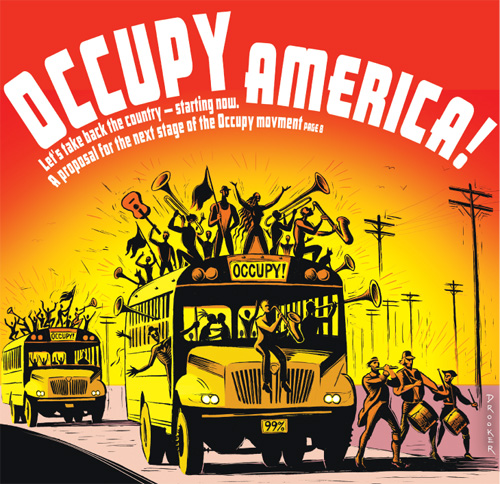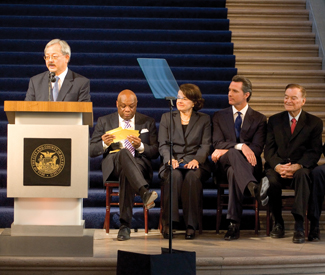WEDNESDAY 25
The Gary Bartz Project feat. Bilal and Aloe Blacc
There’s a bunch of shows taking place this week for the corporate philanthropy/ musical TED conference that is The Red Bull Music Academy. Most interesting to me is this jazz event with saxophonist Gary Bartz and singers Bilal and Aloe Blacc. Both singers have a proven versatility, crossing between hip hop and R&B, that should help them match Bartz’s range. Given his lengthy career spent playing in ensembles with Miles Davis, Donald Byrd, Cecil Taylor, and many more, along with his own genre-bending NTU Troop and releases including the Mizell Brothers produced classic soul jazz record, Music Is My Sanctuary, Bartz can certainly go in a lot of directions. (Ryan Prendiville)
8 p.m., $30
Yoshi’s Jazz Club
1330 Fillmore, SF
(415) 655-5600
THURSDAY 26
Avengers
Here’s a good time to remind listeners of a certain punk truism: while your favorite band has grown iconic thanks to its place in a scene decades ago, it didn’t remain stagnant, locked forever in your personal memory. With shocks of lightning white spiked hair, the Avengers first stormed the San Francisco punk underworld in 1977, and while the band is now rereleasing two (sturdy punkwave) albums from its short-lived initial go at it (a period which included opening for the Sex Pistols in SF), it never has dwelt too long on the past. Prolific lead singer Penelope Houston has continued to break down barriers — for women, for talented lyricists ’round the world — and she keeps on releasing folk-tinged solo records under her own name, including 2012’s On Market Street. Yet she also keeps spreading the Avengers lore with live shows like this one. (Emily Savage)
With Boats!, and Midnight Snaxx
9 p.m., $13
Bottom of the Hill
1233 17th St., SF
(415) 621-4455
Fitz and the Tantrums
The two-toned cover of its 2010 debut album Pickin’ Up the Pieces — featuring singers Michael Fitzpatrick and Noelle Scaggs — will tell you the basic story: he’s cool and she’s hot. With Fitz and the Tantrums’ Motown throwback sound it’s sort of an Ike and Tina set-up, or, given Fitzpatrick’s white soul, Hall and Oates with a statuesque beauty instead of, well, Oates. Whatever. Having seen the group open for and nearly upstage Sharon Jones and the Dap-Kings, I can say that it’s not on the sleeve or even the record that FATT has it going on, it’s as a stellar live act, driven by the pair’s bombastic charisma and a tight, sax-driven, soul-strutting band.(Prendiville)
With Dale Earnhardt Jr. Jr., American Tomahawk
8 p.m., $25
Regency Ballroom
1300 Van Ness, SF
(800) 745-3000
Push the Feeling
There’s a new monthly party in Lower Haight, and it’s for everyone of course (because we are all special), but it’s especially for those of us who frequent dives bars more often than large-scale clubs. Push the Feeling mixes DJs with the art of live electronic music. First up in this series, there will be DJ sets by YR SKULL — who also happens to be one half of Silver Hands — and epicsauce DJs, along with a performance by Magic Touch (a.k.a Damon Palemro of Mi Ami). Using a variety of drum machines and other digital instruments, Magic Touch — whose debut record, I Can Feel The Heat, was released on 100% Silk last year — creates a sound described as 90s-era house meets vintage disco. Did I mention the whole shebang it totally free with RSVP? Let’s hope this feeling lasts forever. (Savage)
9 p.m., free with Facebook RSVP
Underground SF
424 Haight, SF
www.epicsauce.com/pushthefeeling
FRIDAY 27
Ghostly Meets Spectral
The As You Like It crew is presenting this party as a showcase for sister labels Ghostly International and Spectral Sound, and while exciting on its own, that’s not the whole picture. The headlining electronic avant-pop and dance labels will certainly be represented — by Ryan Crosson (half of Bird & Souls or a quarter of Visionquest, depending on your measure), Osbourne, and a live set by the lightly industrial Solvent — but there will also be a stellar deep house and disco lineup in the Oddjob room upstairs. Most notably Let’s Play House and DFA DJ Jacques Renault, as well as a collab set between wolf + lamb’s Eric Johnston and AYLI’s Rich Korach. (Prendiville)
With Mossmoss, Conor, and Brian Bejarano
9 p.m., $10-15 Presale
Public Works
161 Erie, SF
(415) 932-0955
So I Married Abraham Lincoln…
Get your #HonestAbe hashtag ready: it is officially the Year of Abraham Lincoln. The 16th president is trending big-time nearly 150 years after his death. Hollywood knows it, with both Spielberg biopic Lincoln — just give Daniel Day-Lewis the damn Oscar now — and horror fantasy Abraham Lincoln: Vampire Hunter slated for release. Just ahead of what would’ve been Abe’s 203rd birthday, local choreographer Randee Paufve debuts So I Married Abraham Lincoln…, focusing on the life of troubled First Lady Mary Todd Lincoln. Paufve Dance’s seven performers bring history to (surreal) life, with ghostly characters including the stovepipe hat-wearing prez himself. Mrs. Lincoln, famously fascinated with spiritualism, would’ve approved. (Cheryl Eddy)
Fri/27-Sat/28, 8 p.m.; Sun/29, 7 p.m., $15–$18
Dance Mission Theater
3316 24th St., SF
SATURDAY 28
“Pop My Culture”
Pop My Culture found itself toward the top of many a “best of” list this past year — and rightfully so. The podcast kind of embodies what can be so simple and charmingly effective about the form, with its no frills mix of comedy and pop culture discussion. Hosted by SF Sketchfest co-founder Cole Stratton and comedian Vanessa Ragland, the Los Angeles-based show succeeds in large part because of the duo’s upbeat and engagingly dorky senses of humor, in addition to some inspired guest choices (Dave Coulier! Rider Strong!). Stratton and Ragland will be joined by Drew Carey for this special live recording of the show. (Landon Moblad)
1 p.m., $20
Eureka Theatre
215 Jackson, SF
(415) 788-7469
Diavolo Dance Company
In dance we have learned to distrust virtuosity as empty if it is touted for its own sake. We want more than gymnastics or circus. If truth be told, those flip distinctions have always been too easy. There is something eminently poetic about the body pushing itself to the extremes of its capabilities. Jacques Heim’s Diavolo Dance Company works inside that blur of categories. Heim puts his artists into unstable, constructed environments where they leap like antelopes, fly like birds, and swim like fishes. His newest piece, “Fearful Symmetries” is performed on a shape-shifting cube and choreographed to John Adams’ eponymous orchestral score. The program, which also includes excerpts from the previously seen “Trajectoires,” is realized on a huge rocking platform resembling a boat on high seas. (Rita Felciano)
8 p.m., $28–$68; 3 p.m., $14–$34,
Stanford University Memorial Auditorium, Palo Alto
(650) 725-ARTS
livelyarts.stanford.edu
Haunted by Heroes
Haunted by Heroes goes to 11 — years old. Billed as the “world’s youngest rock band,” the Pacifica quintet have the power and skill to transcend their fresh-faced gimmick. Rock and roll music has always subsisted on a measure of childlike abandon — think Angus Young doing the duck walk, or Keith Moon’s flamboyant drumming — but Haunted by Heroes has the real thing. Mixing a few originals with classic covers, their energetic live shows suggest a bright future for five local headbangers, including Geddy, their aptly named lead guitarist. (Ben Richardson)
With Damage, Inc. (Metallica Tribute), Ozzy Alive
9 p.m., $13
Slim’s
333 11th St., SF
(415)-255-0333
“Jon Benjamin Has a Van”
Most known for his voice acting roles on animated hits such as Dr. Katz, Home Movies, Bob’s Burgers, and Archer, Jon Benjamin has perfected the art of the sarcastic and subtly snarky delivery. Last year saw him step outside of the vocal booth and into regular live action work with the Comedy Central show Jon Benjamin Has a Van, a wild mix of man-on-the-street interviews, sketch comedy, and collaborations with the likes of Tim and Eric (Awesome Show, Great Job!, Tom Goes to the Mayor). Benjamin and the rest of the cast will be rolling through Cobb’s this week as a part of SF Sketchfest. (Moblad)
8 p.m., $25
Cobb’s Comedy Club
915 Columbus, SF
(415) 928-4320
SUNDAY 29
“Doug Loves Movies”
Stand-up comic, writer, and award-winning stoner Doug Benson sets his sights on the film world with his “Doug Loves Movies” podcast. Though it often includes some legitimate movie analysis, the show is really more of a medium for Benson to hangout and riff with his comedy buddies — which is more than fine for the podcast’s legions of devoted listeners. The guest list from the show’s two seasons reads like a who’s who of the modern comedy scene (Patton Oswalt, David Cross, Sarah Silverman, Paul F. Tompkins), so it’ll be interesting to see which yet-to-be-revealed performers Benson has planned for this panel discussion and live podcast recording. (Moblad)
4:20 p.m., $20
Cobb’s Comedy Club
915 Columbus, SF
(415) 928-4320
MONDAY 30
Graveyard
The top comment on the YouTube page for the lo-fi, black and white video for Graveyard’s “Hisingen Blues” sums it up pretty well: “How is this not from the ’70s?” Confusion, feigned or actual, can be easily understood once the song begins, and mustachioed long-hairs commence with the sweet, soulful, psyched-out metal, pleading “Awww, Lucifer — come take my hand!” You’d be forgiven for assuming these dudes arrived via time machine from Flower Power-era Frisco, but nay. These lads hail from Gothenburg, Sweden, a place known more for melodic death metal than stony throwback jams. “Where is the future?” Graveyard asks. Clearly, it’s been (awesomely) inspired by the past. (Eddy)
With Radio Moscow and Green and Wood
8 p.m., $12
**UPDATED VENUE:
Slim’s
333 11th St., SF
(415) 861-5016
TUESDAY 31
“Reggie Watts: Just the Music”
Can a comedian be taken seriously as a musician? Would they want to? How precisely does one make a fuck shit stack? These are just a few of the questions surrounding Reggie Watts, a performer hailed as both “Black Galifianakis” and “a human dandelion.” The former singer of Seattle’s Maktub, Watts emerged as a solo artist in recent years, with appearances on Conan (and as opener for The Legally Prohibited From Being Funny On Television Tour) and at LCD Soundsystem’s final show. Blending beat boxing, an array of vocal styles, and looping pedals, Watts is building a reputation for being able to do anything. The first night of SF Sketchfest’s four-part “Reggidency,” this will focus on Watts’s solo music, wherever he draws that line. (Prendiville)
8 p.m., $25
Yoshi’s Jazz Club
1330 Fillmore, SF
(415) 655-5600
The Guardian listings deadline is two weeks prior to our Wednesday publication date. To submit an item for consideration, please include the title of the event, a brief description of the event, date and time, venue name, street address (listing cross streets only isn’t sufficient), city, telephone number readers can call for more information, telephone number for media, and admission costs. Send information to Listings, the Guardian Building, 135 Mississippi St., SF, CA 94107; fax to (415) 487-2506; or e-mail (paste press release into e-mail body — no text attachments, please) to listings@sfbg.com. Digital photos may be submitted in jpeg format; the image must be at least 240 dpi and four inches by six inches in size. We regret we cannot accept listings over the phone.








